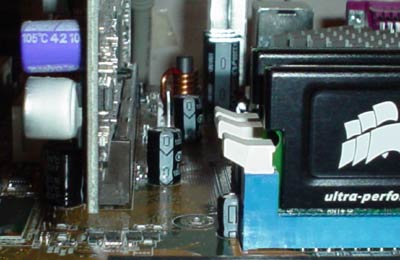nForce2 6-way Motherboard Roundup - December 2002
by Evan Lieb on December 4, 2002 6:53 PM EST- Posted in
- Motherboards
ASUS A7N8X: Board Layout
There were very few layout issues with the ASUS A7N8X. This nForce2 motherboard had one of the better layouts for the most part.
Looking at the positioning of the ATX (20-pin) connector, we see that ASUS placed it on the right-hand side of the motherboard. This is the best place to position an ATX connector, as the thick wires won't obstruct the installation/uninstallation of the HSF or passive North Bridge heatsink, as well as any other components that you may decide to modify or uninstall. Unfortunately, the ATX connector isn't located high enough; the ideal position would be at the very top, right-hand corner of the motherboard, perhaps just over the DIMM slots.
We're glad that ASUS places the Primary and Secondary IDE connectors to the right of the DIMM slots and just above the midsection of the motherboard. We've experienced what a hassle it can be to have the Primary and Secondary IDE connectors placed on the lower portion of the motherboard. It makes it more difficult for the IDE cables to reach to the uppermost bays of a large-sized ATX case, which can get tangled up with the video card.

There are a lot of motherboard makers that place their DIMM connectors too close to where the video card is installed. However, ASUS doesn't make this mistake, and places their DIMM connectors far enough away from our GeForce4 Ti4600 and with a fair amount of room to spare, as is apparent from the motherboard picture in the previous section. We always like it when mainboard manufacturers do this because we're not forced to uninstall the video card if we want to uninstall memory, which is a common occurrence for people who upgrade frequently.
The USB and FireWire headers are positioned fairly well. There is one lone USB header located at the bottom of the board, right where it should be. There are also two (white) FireWire headers located on the left-hand side of the motherboard, right next to the RTL8801B controller. The FireWire header position isn't as good, since the bracket wires will get in the way of other PCI cards (assuming you decide to install one).










1 Comments
View All Comments
c627627 - Monday, July 21, 2003 - link
MSI contradicts your reviewhttp://www.anandtech.com/mb/showdoc.html?i=1759&am...
You say:
"12/04/02 UPDATE: MSI sends word that the K7N2-L indeed does not have a PCI bus lock at 33MHz."
To this day, that was used as ultimate proof that the original MSI nForce2 mobo does not have a PCI lock.
Today MSI Senior Moderators said:
"they are wrong,and who ever told them it did not from msi"
(!)
Source:
http://www.msi.com.tw/program/e_service/forum/thre...
Won't you please settle this for us.